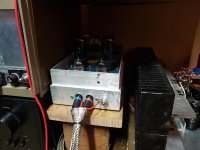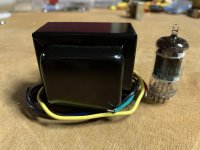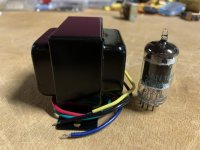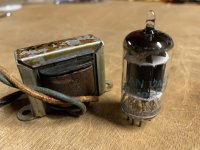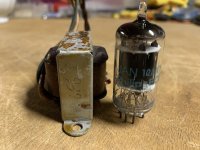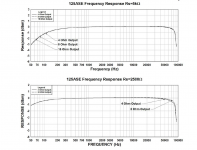AllenB: With such a tiny amount of power required to drive our HF sections, what does an appropriate OPT end up looking like? The assumptions in place for what most OPTs are required to be are very far from the reality of what our HF sections require. It’s an unusual requirement.
Last edited:
Time has passed since I was actively designing output transformers, but they're not intuitive and I'm not comfortable filling in the gaps. What I have said here was based on measurement.
This one was fine until the mid 20's (kHz). I have this one photo (I could probably take more with internals if you like), you can just see the steel box attached to the back of the aluminium section. The transformers are similar in size to the 6V6s.
Just a thought.. a transformer designed for a low impedance primary load may have less turns, and you can increase the secondary impedance using resistance at the speaker at the cost of a little attenuation.
This one was fine until the mid 20's (kHz). I have this one photo (I could probably take more with internals if you like), you can just see the steel box attached to the back of the aluminium section. The transformers are similar in size to the 6V6s.
Just a thought.. a transformer designed for a low impedance primary load may have less turns, and you can increase the secondary impedance using resistance at the speaker at the cost of a little attenuation.
Attachments
AllenB: Thanks for the photo! I'm most likely to try using one of the many small opts I have on hand or, if i decide to commit more seriously with my wallet, contact an OPT builder to do a pair for me.
If you bi-amp, then it really doesn't matter that the treble amp has a full range OPT because there is next to no current drawn for frequencies below 630hz, even if the amp is before the crossover.
I missed this post earlier on in the thread and asked a question about this a few posts later. Just to confirm, if you have a small but full range OPT and you put a full range signal through it, but follow it with a high pass crossover to a HF driver, the OPT will not have the current it normally would have running through it in full frequency operation. It follows that the OPT would also be able to pass more watts at HF if it is freed from operating in the bass frequencies. Is this correct?
sser2: Do you know of any examples of an HF transformer as you describe in current production?
No, nobody is doing tube bi-amping or tri-amping transformers. You have to wind it yourself. Pretty easy task though.
Music power requirements at frequencies above 1-2 kHz are much lower than in mid-bass. This, and quadratic increase of power handling with frequency allows making a very small HF transformer.
Such transformer can be wound with thinner wire than big transformer - for the same winding DCR. Smaller coil diameter and lower number of turns result in lower winding capacitance. Compact coil due to thinner wire, smaller transformer size, and lower number of turns results in lower leakage inductance (better coupling between windings) without need to be interleaved.
These are transformer design basics, not my fancy. For those who don't believe, look at the design of SMPS power transformers, and you may learn something.
Such transformer can be wound with thinner wire than big transformer - for the same winding DCR. Smaller coil diameter and lower number of turns result in lower winding capacitance. Compact coil due to thinner wire, smaller transformer size, and lower number of turns results in lower leakage inductance (better coupling between windings) without need to be interleaved.
These are transformer design basics, not my fancy. For those who don't believe, look at the design of SMPS power transformers, and you may learn something.
Bigger core and larger winding window enables you to use thicker wire ( in primary and secondary ) in accordance with power output . So you get the same inductance or higher with fewer turns . And the big core also won't saturate that easily of course . So it is both for overall power output and bass .
Bigger core may have larger cross-section, but it may also have longer magnetic path, so not necessarily more inductance with fewer turns.
You are repeting yourself with those SMPS transformers , but everyone should know that they are interleaved , the standard is that the secondary is sitting between 2 primary sections . OK , the simplest interleaving , but even with such low number of turns the leakage inductance is high enough to cause problems and must be reduced .
And of course some are much more complex than that ...
And of course some are much more complex than that ...
Last edited:
I missed this post earlier on in the thread and asked a question about this a few posts later. Just to confirm, if you have a small but full range OPT and you put a full range signal through it, but follow it with a high pass crossover to a HF driver, the OPT will not have the current it normally would have running through it in full frequency operation. It follows that the OPT would also be able to pass more watts at HF if it is freed from operating in the bass frequencies. Is this correct?
That's how I see it. You probably don't need more HF watts in your case as your speakers are so sensitive so a small OPT (5-10watts full range) could work well. Also use the smaller one if you have several on hand as the size and wire gauge is largely determined by the low frequency power requirement.
batteryman: It was implied earlier in this thread that an OPT that receives a full signal, and then drives a speaker through a high pass filter, would be still be affected by having to pass those lower frequencies. I honestly don't know the answer, and asked the question for that reason. It does follow that very small vintage OPTs, like many of the ones I have on hand, were designed to operate only at higher frequencies. Some of the other folks posting on this thread say that even if these OPTs were designed for higher frequencies, they lack the interleaving that they say is required in order to accurately reproduce those frequencies.
Regarding the implication, before you design your amp, have the speaker done. Power it through another larger amp, and look at the speaker terminal on your scope. Try a high volume level and try with and without the bass.
AllenB: I bought a used but working scope a while back, but haven't tried it out yet. It's on list of things I really need to get to...
If the amp will be SE there are some cheap chinese transformers described to be interleaved for example 4 + 3 , for deep bass probably weak but in theory very good for what you want 😀
10w Single ended 6P6P EL34 FU50 FU7 tube amp output audio transformers 3.5k output of 0 4 8 Ohm 1pcs|Amplifier| - AliExpress
10w Single ended 6P6P EL34 FU50 FU7 tube amp output audio transformers 3.5k output of 0 4 8 Ohm 1pcs|Amplifier| - AliExpress
batteryman: It was implied earlier in this thread that an OPT that receives a full signal, and then drives a speaker through a high pass filter, would be still be affected by having to pass those lower frequencies. I honestly don't know the answer, and asked the question for that reason. It does follow that very small vintage OPTs, like many of the ones I have on hand, were designed to operate only at higher frequencies. Some of the other folks posting on this thread say that even if these OPTs were designed for higher frequencies, they lack the interleaving that they say is required in order to accurately reproduce those frequencies.
You don't get it. The current flowing through the transformer depends upon the load. The load varies with frequency and as your crossover is blocking low frequencies, there is little current flowing below the crossover frequency.
If the amp will be SE there are some cheap chinese transformers described to be interleaved for example 4 + 3 , for deep bass probably weak but in theory very good for what you want 😀
10w Single ended 6P6P EL34 FU50 FU7 tube amp output audio transformers 3.5k output of 0 4 8 Ohm 1pcs|Amplifier| - AliExpress
Thanks for the link. I had a look and found one that might be appropriate.
This one is the 5K to 4/8 Ohms that I’m looking for, and it says...
“Winding method; 3+2 fever grade winding”
QUOTE]
5K 5W Single ended 6P1 6P14 6p6 tube amp output audio transformers import Z11 output 0 4 8 Ohm 1PCS|Amplifier| - AliExpress
Last edited:
You don't get it. The current flowing through the transformer depends upon the load. The load varies with frequency and as your crossover is blocking low frequencies, there is little current flowing below the crossover frequency.
I didn’t get it. That’s why I’m asking the questions. Thanks for answering this one so clearly. Now I get it!
If the amp will be SE there are some cheap chinese transformers described to be interleaved for example 4 + 3 , for deep bass probably weak but in theory very good for what you want 😀
10w Single ended 6P6P EL34 FU50 FU7 tube amp output audio transformers 3.5k output of 0 4 8 Ohm 1pcs|Amplifier| - AliExpress
The OPTs arrived today. They are larger than I expected. Check out the attached photos of them next to a 12AX7 for scale. I also included a photo of a pair of OPTs that were in a 1950’s 6F6 amp. They are much smaller. I am wondering how important winding geometry is when an OPT is as small as the 6F6 one is? The 6F6 OPT has very little wire on it compared to any of the modern full range OPTs that I have at hand. It is much smaller than the OPTs that were just delivered. Is it possible that winding geometry is less of a factor with so little wire in such close proximity?
Attachments
Thanks for your recommendation. I am using the 125CSE in my current treble amp, and it does sound very good in that role, but was looking for something really small that was also segmented/interleaved. Do you know what the winding geometry of the Hammond is? I couldn’t find any information online about it last time I looked, which was a while ago. I have this transformer on hand, AliExpress.com - Maintaining
and I have this one on order, https://m.aliexpress.com/item/10050...tedetail&spm=a2g0s.9042311.0.0.61d44c4djG4PsB
Both are allegedly segmented/interleaved, and not are very cheap. I haven’t tried them out yet.
and I have this one on order, https://m.aliexpress.com/item/10050...tedetail&spm=a2g0s.9042311.0.0.61d44c4djG4PsB
Both are allegedly segmented/interleaved, and not are very cheap. I haven’t tried them out yet.
- Home
- Amplifiers
- Tubes / Valves
- Best OPT for use over 400 HZ
